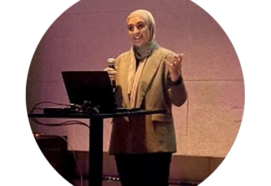There have been growing levels of awareness by professionals of harmful sexual behaviours among children and young people. This webinar will focus on the connection between the digital world and harmful sexual behaviours, and assessment and intervention. The ACAMH Northwest branch presented this half day conference on sexually harmful behaviours in children and young people. The webinar focused on several key presentations, questions and discussion.
Slides from Christine McCarlie
Slides from Jennifer Allotey
Slides from Dr. Shermin Imran, John Hicklin, and Jill Goodwin
ACAMH Members can receive a CPD certificate, simply email and let us know the date and time that you watched the recording.
Learning outcomes
- Provide delegates with an overview of sexually harmful behaviours in children and young people
- Create a framework of understanding of assessment and interventions in sexually harmful behaviours.
- Equip delegates to identify and deal with technology assisted sexually harmful behaviours.
About the talks
Christine McCarlie – ‘Assessment, Intervention and Moving on: AIM Frameworks for assessment and intervention with adolescents with harmful sexual behaviours’
This presentation will describe how the AIM assessment, intervention and reviewing processes are used when working with young people with problematic and/or harmful sexual behaviours.
It will provide an overview of the AIM3 assessment model and the five domains contained within it. It will show how the information contained within the domains is analysed to develop a profile of the young person and their environment, and how this profile is used to inform risk, areas of need and required interventions.
The presentation will also provide an overview of the AIM Intervention Framework. This offers a trauma informed four staged approach to interventions. It recognizes the significant role adults play in managing risk and also in supporting young people through a process of change. It will describe the stages contained within the framework and give examples of work with young people and adults. It will highlight the importance of effective multi agency risk management processes to ensure that risk is managed, monitored and evaluated whilst interventions are underway.
Learning Outcomes
- To provide an understanding of the AIM3 Model of Assessment, its structure, language and content
- To provide an awareness of the four stage trauma informed AIM Intervention Framework
- To provide an awareness of the theories and approaches informing this framework.
Jennifer Allotey – ‘Growing up in a digital world: How to recognise and respond to technology assisted harmful sexual behaviour’
Technology is now integral in the lives of children and young people. Whilst this brings many benefits, it is also an area in which young people can harm and be harmed. This presentation will explore ways in which technology can feature in harmful sexual behaviours displayed by children and young people and how professionals can recognise and respond to this.
Learning outcomes
- To recognise the ways in which technology can be used in a harmful way by children and young people
- To consider how to respond to technology-assisted sexual harm displayed by children and young people
Dr. Shermin Imran, John Hicklin, and Jill Goodwin – ‘Harmful Sexualised Behaviours in Adolescents- FCAMHSNW overview and 2 case studies’
This presentation describes some data and key factors relating to presentation of harmful sexualised behaviour in young people up to 18 years of age. We explore relevance of identifying and treating neurodevelopmental and any other co-morbid mental health difficulties, increasing the vulnerability and complexity of such presentation. We discuss issues of digital literacy across generations and how we advise and support relevant agencies in their duty to ensure safeguarding and risk management, as an ongoing dynamic process. We describe key principles of intervention and how these may need to be adapted in practice. We present 2 exemplar cases of young people presenting with harmful sexualised behaviour discussing the relevant factors in their assessment and intervention. These cases have been developed for this presentation reflecting some of the common issues observed during clinical practice.
Learning outcomes
- To understand the presentation of harmful sexualised behaviour and relevant factors in young people
- To recognise the key principles of safe intervention with adolescents
- To discuss application of these principles in practice.
About the speakers
Jennifer Allotey – Jennifer is a Social Worker and Forensic Psychologist in Training. She has worked in the area of harmful sexual behaviour for many years with children, young people and adults. In addition to experience as a social worker within a child protection team and working within the Probation Service, Jennifer has worked in a range of specialist services including NSPCC, Lucy Faithful Foundation, FCAMHS and Safer Lives. Jennifer is an associate of the AIM Project and co-author of the Technology- Assisted Harmful Sexual Behaviour Practice Guidance.
John Hicklin – Recently retired after 38 years mental health nursing, the last 23 years spent in forensic CAMHS. Caseload consistently included complex SHB cases at both assessment and intervention level. Completed a research study in the field and relevant training. Latterly assisted colleagues who recently joined the service in acquiring assessment and intervention skills.
Dr Shermin Imran is a child and adolescent psychiatrist currently working in and leading the Forensic CAMHS outreach service for the North West. She has over 10 years’ experience of working in the Tier 4 services for adolescents in Manchester, is a clinical lead for GMMH CAMHS services, and an elected member of the NHSE CAMHS Clinical Reference group.
Jill Goodwin – Qualified social worker with over 20 years experience in a variety of roles. Currently work in the regional Forensic CAMHS service in the North West, the role involves working across agencies to facilitate formulation, risk management and some assessment and intervention of young people.
Christine McCarlie has been a Social Worker for over 37 years, specialising in working with children and young people with harmful sexual behaviours since 1994. She is an Associate trainer for the AIM Project, delivering training on the AIM Assessment Models and Intervention. She co-authored AIM Intervention Guidance: working with adolescents, their families and carers re harmful sexual behaviours, (2019). Within her role as Director of Safer Futures Ltd she provides consultation, training and direct work with young people



Discussion
Hi how do I get access to this video and slides?
Hi, is it possible to get the access code to watch this CPD?
Thank you
Hi,
How can we obtain the code for the presentation slides?
Thank you fir such great training.
HI. I am afraid that these are only currently available for delegates.